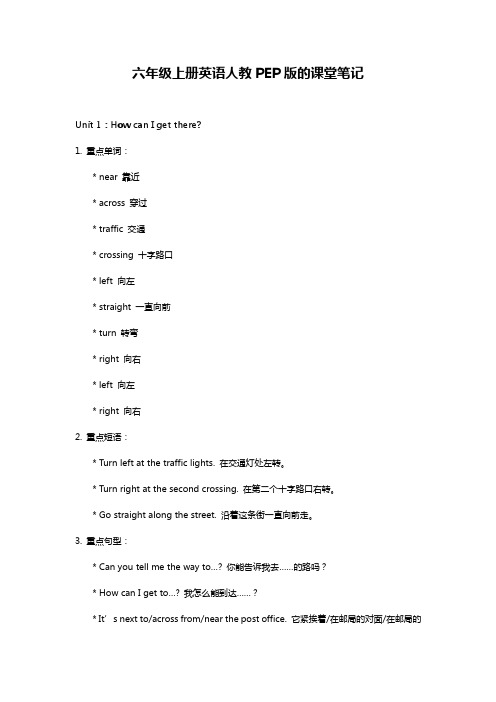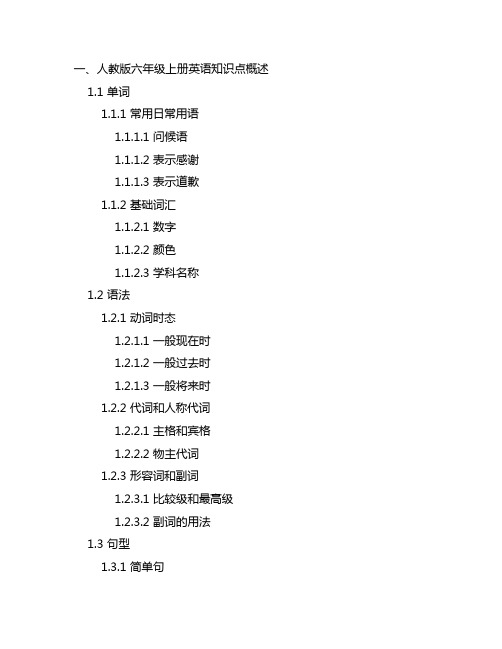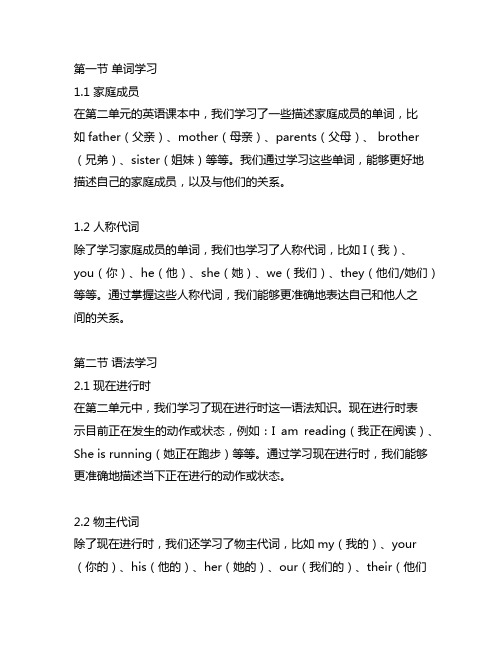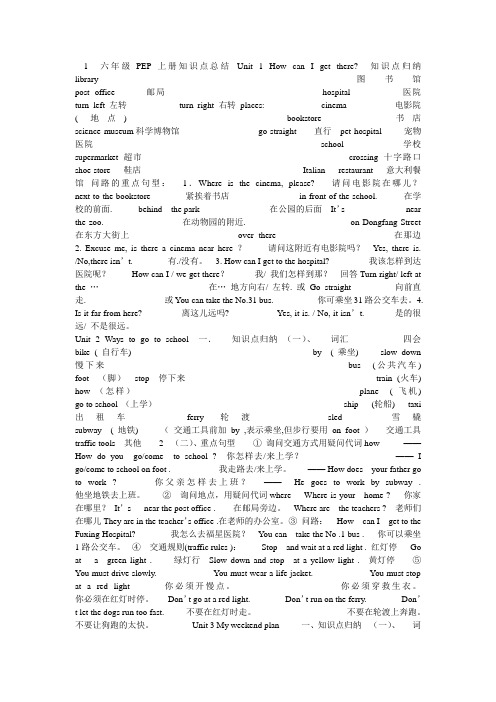人教版六年级上册英语笔记
pep六年级上册英语笔记

六年级上册英语人教PEP版的课堂笔记Unit 1:How can I get there?1. 重点单词:* near 靠近* across 穿过* traffic 交通* crossing 十字路口* left 向左* straight 一直向前* turn 转弯* right 向右* left 向左* right 向右2. 重点短语:* Turn left at the traffic lights. 在交通灯处左转。
* Turn right at the second crossing. 在第二个十字路口右转。
* Go straight along the street. 沿着这条街一直向前走。
3. 重点句型:* Can you tell me the way to…? 你能告诉我去……的路吗?* How can I get to…? 我怎么能到达……?* It’s next to/across from/near the post office. 它紧挨着/在邮局的对面/在邮局的附近。
4. 语法知识:* 用“Can you tell me the way to…?”和“How can I get to…?”询问道路和交通方式。
* 用“next to/across from/near”等介词表达位置关系。
5. 功能话题:问路和指路,描述位置关系。
6. 文化知识:了解不同国家的交通规则和交通标志。
Unit 2:Where is the science museum?1. 重点单词:* science museum 科学博物馆* library 图书馆* hospital 医院* cinema 电影院* post office 邮局2. 重点短语:* Excuse me. 对不起。
* Thank you very much/a lot. 非常感谢你。
3. 重点句型:- Excuse me, where is the science museum? 对不起,请问科学博物馆在哪里?- It’s next to/across from/near the post office. 它紧挨着/在邮局的对面/在邮局的附近。
六年级上册英语人教版笔记

六年级上册英语人教版笔记Unit 1: Meeting new people1. Greet people- Hello! How are you?- Hi! Nice to meet you.- Good morning/afternoon/evening.2. Introduce themselves- My name is...- I am from...- I am in Grade 6.3. Ask for and give personal information- What's your name?- Where are you from?- How old are you?- What grade are you in?4. Talk about their family- I have a big family.- I have a sister and a brother.- I live with my parents.Unit 2: My school1. Talk about school facilities- Our school has a library.- We have a computer room.- The playground is big and beautiful.2. Describe school subjects- I like English.- I am good at Math.- Science is interesting.3. Discuss school activities- We have art classes.- I enjoy P.E. lessons.- We have music lessons.Unit 3: My home1. Describe their rooms- I have a big bedroom.- My room is clean and tidy.- I have a desk and a bookshelf.2. Discuss household chores- I help my parents with the dishes. - I feed the pets.- I water the plants.3. Talk about their neighborhoods- Our neighborhood is quiet.- There is a park nearby.- The people are friendly.Unit 4: My day1. Describe daily routines- I wake up at 7 o'clock.- I brush my teeth and wash my face. - I go to bed at 9 o'clock.2. Talk about free time activities - I play football with my friends. - I read books in my free time.- I watch TV after school.3. Discuss meals and snacks- I have breakfast at 7:30.- I take sandwiches to school for lunch. - I have fruit for a snack.。
人教版六年级上册英语笔记

Lesson 2一、祈使句1、有呼语的出现:Tom, open the door. Tom is opening the door.2、否定句的变化:动词前加don’t. Please don’t do it like this.3、祈使句中be的出现:Be early .Be active .Be careful. Be quiet.Don’t be late.4、祈使句的反义疑问句:①.Let me have a look , shall I ?②.Let’s go to the zoo, shall we ?③.除此以外,无论肯定句和否定句都是will you?Let us go home , will you ?Don’t watch TV , will you ?二、形容词与副词的用法1、通常形容词后加ly即可变成副词,但是有的词既是形容词又是副词,例如:①hard 艰苦的,努力地hardly 几乎不②early 早的,早地③fast 快的,快地④easy 容易的,容易地2、用法形+名be+形动+副Lesson 1一、everyone in school(同义)1、all of us (复)2、each of us (单)二、in class 在课上(时间)in the class 在班里(地点)三、宾语从句,从句用陈述句1、Do you think they are right?2、I know how old he is.四、让某人干某事1、Let sb. do sth. (否)Let sb. not do sth.2、make sb. do sth.3、tell sb. to do sth. (否)tell sb. not to do sth.4、ask sb. to do sth. (否)ask sb. not to do sth.5、keep sb. doing sth.Lesson 4一、should句型1、肯:主+should+动原+其它2、否:主+shouldn’t+动原+其它二、help的用法help to do sth. 帮着干1、动词help sb. (to) do sth. 帮助某人干某事help sb. with sth. 在某方面帮助某人2、名词:I want some help.三、名词做定语1.单数只有sports,以复数修饰:a sport s shop2.复数只有man…、woman…,两个都变,其它只变第二个(m e n teacher s、wom e n teacher s)四、too的用法1、也。
人教版六年级上册英语知识点汇总

一、人教版六年级上册英语知识点概述1.1 单词1.1.1 常用日常用语1.1.1.1 问候语1.1.1.2 表示感谢1.1.1.3 表示道歉1.1.2 基础词汇1.1.2.1 数字1.1.2.2 颜色1.1.2.3 学科名称1.2 语法1.2.1 动词时态1.2.1.1 一般现在时1.2.1.2 一般过去时1.2.1.3 一般将来时1.2.2 代词和人称代词1.2.2.1 主格和宾格1.2.2.2 物主代词1.2.3 形容词和副词1.2.3.1 比较级和最高级1.2.3.2 副词的用法1.3 句型1.3.1 简单句1.3.1.1 肯定句1.3.1.2 否定句1.3.1.3 疑问句1.3.2 复合句1.3.2.1 并列句1.3.2.2 定语从句1.3.2.3 状语从句二、人教版六年级上册英语知识点详解2.1 单词2.1.1 常用日常用语2.1.1.1 问候语问候语是指在英语日常交际中用于打招呼和示好的常用词汇,包括Hello、Hi、Good morning、Good afternoon等等。
2.1.1.2 表示感谢表示感谢的常用词汇有Thank you、Thanks a lot、Thank you very much等,用于表达对别人的帮助或礼物表示感激之情。
2.1.1.3 表示道歉表示道歉的词汇包括I'm sorry、Excuse me、Pardon等,在日常生活中,用于向别人道歉或请求对方让步的场合。
2.1.2 基础词汇2.1.2.1 数字数字是英语基础词汇的重要部分,包括基本的数字表达方式和计量单位,如one、two、three等,以及hundred、thousand等。
2.1.2.2 颜色颜色是描述事物外观的重要词汇,在日常交流中也经常用到,包括red、blue、yellow等常见颜色词汇。
2.1.2.3 学科名称学科名称涉及到人们日常生活和学习工作的方方面面,包括mathematics、music、art等,是学习英语时必须掌握的词汇。
人教六年级上英语第一单元笔记

人教六年级上英语第一单元笔记
以下是人教版六年级上英语第一单元的笔记:
1. 重点词汇:science, museum, post office, bookstore, cinema, hospital, crossing, turn left, turn right, go straight
2. 重点句型:- Where is the museum? - It's near the hospital.
3. 方位介词:in front of, behind, near, next to, between, across from
4. 问路和指路的表达方式:- Excuse me, how can I get to the hospital? - Turn left at the first crossing and then go straight.
5. 一般现在时的用法:表示经常发生的动作或存在的状态,常与频率副词连用,如always, usually, often, sometimes, never 等。
6. 名词复数形式的变化规则:一般情况下,在名词末尾加-s;以s, x, ch, sh 结尾的名词,在末尾加-es;以辅音字母+y 结尾的名词,变y 为i,再加-es;不规则变化,如man - men, woman - women, child - children 等。
以上是第一单元的重点内容,希望对你有所帮助。
六年级上册英语笔记人教版第二单元

第一节单词学习1.1 家庭成员在第二单元的英语课本中,我们学习了一些描述家庭成员的单词,比如father(父亲)、mother(母亲)、parents(父母)、 brother (兄弟)、sister(姐妹)等等。
我们通过学习这些单词,能够更好地描述自己的家庭成员,以及与他们的关系。
1.2 人称代词除了学习家庭成员的单词,我们也学习了人称代词,比如I(我)、you(你)、he(他)、she(她)、we(我们)、they(他们/她们)等等。
通过掌握这些人称代词,我们能够更准确地表达自己和他人之间的关系。
第二节语法学习2.1 现在进行时在第二单元中,我们学习了现在进行时这一语法知识。
现在进行时表示目前正在发生的动作或状态,例如:I am reading(我正在阅读)、She is running(她正在跑步)等等。
通过学习现在进行时,我们能够更准确地描述当下正在进行的动作或状态。
2.2 物主代词除了现在进行时,我们还学习了物主代词,比如my(我的)、your (你的)、his(他的)、her(她的)、our(我们的)、their(他们的/她们的)等等。
掌握这些物主代词,能够更清晰地表达所指物品的归属关系。
第三节句型练习3.1 简单句在第二单元的课本中,我们进行了一些简单句的练习。
简单句是由一个主语和一个谓语构成的简单语句,例如:I am a student.(我是一个学生。
)、She likes singing.(她喜欢唱歌。
)等等。
通过练习简单句,我们能够更熟练地运用所学的单词和语法知识。
3.2 疑问句除了简单句,我们还练习了一些疑问句的语法知识。
疑问句是用来询问信息的句子,例如:Is she your sister?(她是你的姐妹吗?)、Do you like ice cream?(你喜欢冰淇淋吗?)等等。
通过练习疑问句,我们能够更好地和他人进行交流,并获取所需的信息。
第四节阅读练习4.1 短文阅读在第二单元的英语课本中,我们进行了一些短文阅读练习。
六年级英语书课堂笔记

六年级英语书课堂笔记由于不清楚具体是六年级上册还是下册的英语书,以下为人教版六年级上册英语书部分重点课堂笔记:一、Unit 1 How can I get there?1. 重点单词。
- science museum(科学博物馆):science表示“科学”,museum是“博物馆”,这是一个表示地点的名词短语。
- post office(邮局):post有“邮政”的意思,office是“办公室”。
- bookstore(书店):book(书)+ store(商店)。
- cinema(电影院):去看电影的地方。
- hospital(医院):生病就医的地方。
2. 重点句型。
- Where is the + 地点? 例如:Where is the library?(图书馆在哪里?)- It's + 方位介词+地点. 例如:It's near the park.(它在公园附近。
)- How can I get to + 地点?(我怎样才能到达某地?)例如:How can I get to the zoo?(我怎样才能到达动物园?)- Turn left/right at + 地点. (在某地向左/右转。
)例如:Turn left at the second crossing.(在第二个十字路口左转。
)3. 语法点。
- 方位介词:near(在……附近)、next to(紧挨着)、in front of(在……前面)、behind(在……后面)。
二、Unit 2 Ways to go to school。
1. 重点单词。
- by bike(骑自行车):表示出行方式,by + 交通工具,交通工具要用单数形式,且中间没有冠词。
类似的还有by bus(乘公共汽车)、by subway(乘地铁)等。
- on foot(步行):这是一个固定短语。
- slow(慢的):形容词,其反义词是fast(快的)。
(完整版)新人教版英语六年级上册知识点总结

1 六年级PEP上册知识点总结Unit 1 How can I get there? 知识点归纳library 图书馆post office 邮局hospital 医院turn left 左转turn right 右转places: cinema 电影院( 地点) bookstore 书店science museum科学博物馆go straight 直行pet hospital 宠物医院school 学校supermarket 超市crossing 十字路口shoe store 鞋店Italian restaurant 意大利餐馆问路的重点句型:1.Where is the cinema, please? 请问电影院在哪儿?next to the bookstore 紧挨着书店in front of the school. 在学校的前面. behind the park 在公园的后面It’s near the zoo. 在动物园的附近. on Dongfang Street 在东方大街上over there 在那边2. Excuse me, is there a cinema near here ?请问这附近有电影院吗?Yes, there is. /No,there isn’t. 有./没有。
3. How can I get to the hospital? 我该怎样到达医院呢?How can I / we get there?我/ 我们怎样到那?回答Turn right/ left at the …在…地方向右/ 左转. 或Go straight 向前直走. 或You can take the No.31 bus. 你可乘坐31路公交车去。
4. Is it far from here? 离这儿远吗? Yes, it is. / No, it isn’t. 是的很远/ 不是很远。
Unit 2 Ways to go to school 一.知识点归纳(一)、词汇四会bike ( 自行车) by ( 乘坐) slow down 慢下来bus (公共汽车) foot (脚)stop 停下来train (火车) how (怎样)plane ( 飞机) go to school (上学)ship (轮船) taxi 出租车ferry 轮渡sled 雪橇subway ( 地铁) (交通工具前加by ,表示乘坐,但步行要用on foot )交通工具traffic tools 其他 2 (二)、重点句型①询问交通方式用疑问代词how ——How do you go/come to school ? 你怎样去/来上学?——I go/come to school on foot . 我走路去/来上学。
- 1、下载文档前请自行甄别文档内容的完整性,平台不提供额外的编辑、内容补充、找答案等附加服务。
- 2、"仅部分预览"的文档,不可在线预览部分如存在完整性等问题,可反馈申请退款(可完整预览的文档不适用该条件!)。
- 3、如文档侵犯您的权益,请联系客服反馈,我们会尽快为您处理(人工客服工作时间:9:00-18:30)。
2010.8.31Lesson 2一、祈使句1、有呼语的出现:Tom, open the door. Tom is opening the door.2、否定句的变化:动词前加don’t. Please don’t do it like this.3、祈使句中be 的出现:Be early .Be active .Be careful. Be quiet.Don’t be late.4、祈使句的反义疑问句:①.Let me have a look , shall I②.Let’s go to the zoo, shall we ?③.除此以外,无论肯定句和否定句都是will you ?Let us go home , will you ?Don’t watch TV , will you ?二、形容词与副词的用法1、通常形容词后加ly 即可变成副词,但是有的词既是形容词又是副词,例如:①hard 艰苦的,努力地hardly 几乎不②early 早的,早地③fast 快的,快地④easy 容易的,容易地2、用法形+名be+形动+副2010.09.01Lesson 1一、everyone in school(同义)1、all of us (复)2、each of us (单)二、in class 在课上(时间)in the class 在班里(地点)三、宾语从句,从句用陈述句1、Do you think they are right?2、I know how old he is.四、让某人干某事1、Let sb. do sth. (否)Let sb. not do sth.2、make sb. do sth.3、tell sb. to do sth. (否)tell sb. not to do sth.4、ask sb. to do sth. (否)ask sb. not to do sth.5、keep sb. doing sth.2010.9.2Lesson 4一、should 句型1、肯:主+should+动原+其它2、否:主+shouldn’t+动原+其它二、help 的用法help to do sth. 帮着干1、动词help sb. (to) do sth. 帮助某人干某事help sb. with sth. 在某方面帮助某人2、名词:I want some help.三、名词做定语1.单数只有sports,以复数修饰:a sport s shop2.复数只有man…、woman…,两个都变,其它只变第二个(m e n teacher s、wom e n teacher s)四、too 的用法1、也。
You’re 12.I’m 12,too.2、太…(通常接否定句) The girl is too young. She can’t write.3、too…to…(太…以至于不能)The girl is too young to write.五、动名词做定语1、a shopping list 一个购物单2、a writing desk 一张写字桌3、a swimming poll 游泳池4、a guessing game 猜谜游戏5、a camping trip 一个野外旅行2010.9.3Lesson 3一、辨析1、sometimes 有时2、sometime 某个时候3、some times 一些次4、some time 一些时间二、like 的用法1、像(长相、天气…) be like、look likelike doing(兴趣、爱好)2、喜欢Like to do(具体一件事,通常有时间、地点的限制3、would like=want 想要三、each 的用法1、each 在前表单数each of+复数=every one of+复数=every+单数2、each 在句中不算数2010.9.6Lesson 5一、must 句型=have to1、肯:主+must+动原2、否:主+mustn’t+动原3、一般问:Must+主+动原+其它?Yes, 主must.※No, 主needn’t二、spit(现在分词)spitting2010.9.8Lesson 6一、标语1、祈使句肯定句:Keep your desk clean.2、No+名词No photo.3、No+动ing No parking. No spitting.二、in front of(物体外部)在…前面In the front of(物体内部)在...前面三、辨析1、too many+名复太多…2、too much+不可数3、much too+形容词(太…)四、busy(反义)free1、be busy with sth. 在某方面忙碌2、be busy doing 忙着干五、sign(名)标语(动)Sign your name,please.2010.9.10Lesson 8一、一般现在时(经常性)先判断分主语用公式(一)时间状语:1、由in,on,at 引导的时间词组2、频率副词:always、usually、often、sometimes、seldom、never3、every day(week、month、year、Sunday…)4、often/before(lunch、Sunday…)(二)分主语:除三单:I,we,you,they,2 个以上人或物是三单:he,she,it,1 个人或物(三)除三单公式:1、肯:主+动原+其它2、否:主+don’t+动原+其它3、一般问:Do+主+动原+其它?4、特殊问:特疑词+一般问语序?二、in pairs 两人一组in groups 成组的in threes 三人一组三、while 的用法连接 2 个同时进行的动作:While my mother is cooking,I am reading.四、remember 记得与forget 忘记1、Remember/Forget to do.(还没做)2、Remember/Forget doing.(已做过)五、if 如果(条件状语从句,主将从现)1、If it rains, we will stay at home.从句主句2、Don’t go home if you don’t do your homework.主句从句2010.9.15Lesson 7一、辨析 4 个“说”1、say+内容Can you say it in English?2、speak+语言3、tell+人※tell a story 讲故事4、talk(不及物)①、talk about 谈论…②、talk with…与…谈论③、talk in+语言用…交谈二、辨析4 个“看”1、look(看的过程)2、see(看见,强调结果)※see a film 看电影3、watch(欣赏、注视地看)watch TV、watch a football match4、read(看文字)Read a book/newspapers(看书/报)三、bring 拿来与take 带走1、bring 人/物to…把人/物带到…来※bring here/bring home 省to2、take 人/物to…把人/物带到…去※take there/take home 省to四、end(同义)=be overSchool ends at three.=School is over at three.2010.9.16Lesson 10一、主语是三单的一般现在时1、肯:主+动s+其它※(动三单的变化)①直接加s②以s, x, ch, sh, o 结尾+es③y 前不是a, e, I, o, u,y 改ies④特例:have—has be—is2、否:主+doesn’t+动原+其它3、一般问:Does+主+动原+其它?二、get to… 到达…get home 到家、get there 到那儿、get here 到这儿,省略to三、1、go out 出去(反)come in 进来2、go out of… 从…出去come into… 进…来四、play 的用法1、play+球类2、play the 乐器 3.、play with 人/物五、go+动ing 的词组1、go shopping 去购物2、go fishing 去钓鱼3、go skating 去滑冰4、go swimming 去游泳5、go camping 去野营6、go boating 去划船7、go tree planting=go to plant trees 去植树8、go kite flying=go to fly kites 去放风筝2010.9.17Lesson 9一、kind 的用法1、和蔼的①、人对人和蔼用to。
The teacher is kind to us.②、人和蔼。
It’s kind of you to help me.2、名词(种类)a kind of…一种,all kinds of…各种各样的二、辨析few,a few,little,a little+复数+不可数1、few(表否定) I have few friends, I’m new here.2、a few(表肯定) I have a few friends, I like them.3、little(表否定) There’s little water in the glass, is there?4、a little(表肯定)There’s a little water in the glass, isn’t there?三、辨析:1、It’s+形of sb. to do(形容词情感类)2、It’s+形for sb. to do(形容词客观类)3、情感类:kind, nice, friendly ,right, wrong, careful, clever……It’s kind of you to help me.4、客观类:easy 容易的,hard 难的,difficult 难的,interesting 有趣的,important 重要的,useful 有用的It’s important for us to work hard.2010.9.19Lesson 12一、频率的表达1、频率副词6 个(用在be 动词,助动词,情态动词之后,实义动词之前)2、once/twice/three times… a day/week…3、every… 每…4、every other… 每隔…every other day 每隔一天every other two days 每隔两天※频率副词提问用how often二、other 的用法1、one…the other… 一个…另一个…I have two bags. One is big, the other is small.2、the other+名复=the others(剩余全部)There are 40 students in our class.There are 18 boys,the others are girls.3、other+复数=others(剩余部分)Some children like playing football, others like swimming.4、another+单数(众多中的任意一个)This big is big for me,show me another one.2010.9.21Lesson 11一、famous1、be famous for… 因…而著名Yao Ming is famous for basketball2、be famous as… 作为…而著名Yao Ming is famous as a basketball player.二、同位语1、The writer and teacher goes (go) to USA every year.(1 个人)2、The writer and the teacher go (go) to USA every year.(2 个人)三、继续干…1、go on with…2、go on doing…(同一件事)3、go on to do…(另一件事)四、each other 互相(两者)= one another (三者或以上)※所有格each other’s五、主系表结构系动词be,fell,look(看法),sound(听起来),smell(闻起来)+形2010.9.28Lesson 14一、兴趣,爱好的表达1、like doing喜欢干…2、enjoy doing3、do well in…擅长于…4、be good at…5、be interested in… 对…感兴趣6、be fond of… 喜欢…7、Someone’s hobby is… 某人的爱好是…二、不定代词1、不定代词+形容词something new 一些新的东西,someone important 一些重要人物2、不定代词+不定式something to eat 一些吃的东西,something to read… 读…3、不定代词+else 别的…4、不定代词表单数2010.9.29Lesson 13一、both 与all1、共同点:用在be 动词、情态动词、助动词之后,实义动词之前。
